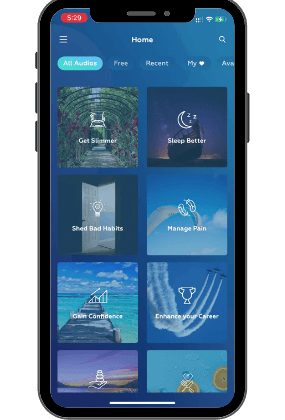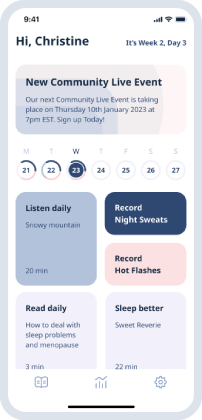
Hypnotherapy for Digestive Health and Regaining Control Over IBS

Discover the Magic of Hypnosis: How a Hypnosis Therapist Can Improve Your Life
Table of contents
- Top Quit Smoking Apps
- App Features
- App Benefits
- Hypnotherapy in Quit Smoking Apps: Does it Work?
- Integrating Nicotine Replacement Therapy with Apps
- E-Cigarettes and Quit Smoking Apps
- Prescription Smoking Medicines and App Support
- Prescription Medication and App Support
- Expert Advice and Counseling within Apps
- Quit Smoking Apps vs In-person Intervention
- Choosing the Right Quit Smoking App for You
- Frequently Asked Questions
For many quitting smoking means much more than getting rid of a bad habit. It is an essential step toward a healthier and longer life. Thankfully, technology has made it easier for us to overcome this hurdle. Apps to quit smoking are designed to guide and support us through the process, making it more manageable and enjoyable. So, are you ready to embark on a life-changing journey to a smoke-free future with the help of these innovative tools?
Short Summary
- Quit smoking apps provide tailored quit plans, symptom tracking and personalized approaches to increase therapy compliance and help users become smoke-free.
- A new generation of quit smoking apps integrates self-hypnosis techniques and offers a safe alternative to nicotine replacement products. Therapy with mobile applications can increase the chances of success while managing nicotine withdrawal symptoms.
- Apps to quit smoking offer community resources, expert advice & counseling for a successful journey towards quitting smoking.
Top Quit Smoking Apps
Quit smoking apps are revolutionizing the way we approach smoking cessation. These digital resources offer a variety of features that cater to different needs, making the journey to quit not only achievable but also personalized. With many tools at your disposal, including innovative hypnotherapy-based programs and progress tracking, there’s no better time to take control of your health and quit smoking for good with a smoking cessation app.
Two Generations of Stop Smoking Apps
There are three primary categories of quit smoking products:
- Self-hypnosis management programs,
- Nicotine replacement therapies and
- Prescription medications.
Self-hypnosis programs are the newest type of digital therapy becoming mainstream after the first generation of quit smoking aids (i.e. medications and nicotine-based products). Quit smoking apps provide access to therapy, a clear quit plan, and an accountability system to transform the users’ smoking habits. Furthermore, these apps can track usage and progress, highlighting the benefits of its program while helping manage withdrawal symptoms and ensuring a smoother transition towards a smoke-free life.
App Features
Self-Management Program and Quit Plan
The most important feature within first-generation quit smoking apps is the ability to create a quit plan, which enables users to establish a quit date and construct a program to assist them in achieving their objective. This plan can encompass setting objectives, monitoring progress, and configuring reminders.
The second generation of smoking cessation apps, which integrates self-hypnosis, dive right away into a carefully crafted hypnotherapy program after setting a few reminders. The progress is also monitored continuously.
Progress Tracking
Quit smoking apps have many features designed to make quitting cigarettes as seamless as possible. These features include self-tracking, which allows users to monitor their progress, such as the number of cigarettes smoked, the amount of money saved, and the number of days since quitting. Another feature is the time won back, reminding us that quitting smoking is about longevity.
By monitoring progress and implementing the strategies and tools provided by quit smoking apps, users can stay motivated and significantly increase their chances of achieving a smoke-free future.
Educational Content
Additionally, Apps to quit smoking can provide education, which may include detailed steps on quitting smoking, advice and techniques for controlling nicotine cravings, and nicotine withdrawal symptoms. The educational content often describes the body’s changes as it weans itself of smoke chemicals.
Encouragement and Support
App users can also benefit from motivational messages and resources, such as tips and advice on how to quit smoking, information on the health benefits of quitting, and support from a community of other quitters. By having access to these resources and support systems, individuals can feel more confident and motivated to continue their smoke-free journey.
App Benefits
Quitting Smoking for a Better Health and a Better Life
Quitting smoking is much more than a lifestyle choice. It can improve your health and the wellbeing of your loved ones. Here are some of its benefits:
- Reduce the likelihood of adverse health events
- Increase longevity
- Reduce secondhand cigarette smoke among family members (secondhand smoke may create negative symptoms in non-smokers)
- Save money: how could you put the money spent on cigarettes or vapes to good use?
Managing Nicotine Withdrawal Symptoms
Withdrawal symptoms are common when quitting smoking and can include:
- nicotine cravings,
- irritability,
- anxiety,
- depression,
- restlessness,
- difficulty concentrating,
- cough,
- headaches,
- fatigue,
- dizziness & light-headedness,
- mouth ulcers, and
- sleep disturbances.
These symptoms typically peak within 1-3 days of quitting and persist for up to two weeks. The three types of stop smoking apps rely on fundamentally different approaches. Let’s find out how they differ.
Hypnotherapy in Quit Smoking Apps: Does it Work?
What Does Science Say?
Empirical evidence and clinical research substantiate the techniques and support delivered digitally. For example, research suggests hypnotherapy may be more effective than counselling or nicotine replacement therapy (NRT). Stop smoking apps like UpNow self-hypnosis bring professionally crafted programs into easy-to-use online programs.
Hypnosis is safe and non-invasive and can provide long-term relief.
Smoking Cessation Acting on the Root Cause
Cravings have a subconscious origin. You cannot silence them consciously. Most people smoke after some triggers are activated. As a result, it makes only sense to treat the issue at its root and remove positive associations with cigarettes, cigars or vapes. These devices are engineered to deliver nicotine, a habit-forming agent, but they also bring toxic chemicals into the brain. Despite the health hazards of cigarettes and vapes, too many people continue using them.
But How Does Hypnosis Work?
Hypnosis allows you to enter a state of deep focus. You cease paying attention to distractions and become entirely focused on one element of experience. fMRI scans showed that the brain of hypnotized people showed some interesting trends. The brain part controlling the body is more active, while the salience network is less active.
The hypnotic state is very relaxing, which can help with symptoms of anxiety and depression. The hypnotherapist helps the client induce and deepen the state before providing suggestions matching the individual’s goals.
A mobile application can deliver the sessions designed by a hypnotherapist. In the case of a stop smoking app, the hypnotherapist employs a series of techniques and appropriate suggestions to facilitate hypnotic learning.
The time commitment is minimal, with about 20 minutes of daily practice. Many people quit smoking and report a sense of control, freedom and achievement as cravings diminish.

Integrating Nicotine Replacement Therapy with Apps
Virtual Clinics for substance use management are blending offline and online support. By complementing the traditional nicotine replacement therapies with a tracking app offering telehealth and one-on-one counselling, these virtual clinics are digitizing an already existing method.
Nicotine Gum and other Nicotine-Based Alternatives
NRT is one of the most popular quit smoking aids for managing withdrawal symptoms and cravings associated with quitting smoking. The purpose of NRT is to slowly overcome the addiction by reducing the nicotine dose. By providing nicotine without the harmful chemicals commonly found in cigarettes, NRTs make nicotine-based products a safer alternative to smoking. In addition, nicotine eases withdrawal symptoms. These products include nicotine nasal sprays, nicotine inhalers, nicotine gums, or nicotine lozenges.
Tracking NRT Usage and Tolerance
Another feature of NRT-based quit smoking apps is the monitoring of NRT usage. This monitoring can ensure users are using the therapy correctly and maximizing its benefits.
Nicotine Replacement Therapy Explained
But how does nicotine replacement therapy work? Nicotine replacement products, such as nicotine mouth spray, gum, nicotine lozenges, and nicotine nasal spray (also called a nicotine inhaler), deliver nicotine through the mucous membranes of the mouth, throat, and nose. Nicotine patches release a small amount of nicotine into the body through the skin. Most nicotine products are sold over the counter, but some, like a nicotine spray or nicotine inhaler, require a medical prescription.
Treatment Duration & Nicotine Side Effects
The typical treatment duration is 12 weeks, but some of these products cannot be consumed for an extended period, according to doctors. For example, nicotine from nasal sprays can manage withdrawal symptoms faster because it can enter the bloodstream quickly. But the FDA recommends a treatment duration of maximum six months. In addition, nicotine nasal spray may create watery eyes and cause sneezing because of its peppery taste.
Each of these nicotine alternatives may have some side effects. For example, nicotine lozenges and gums may cause nausea, heartburn, and hiccups. They can also irritate the mouth. As always, make sure to seek guidance from your doctor when experiencing these symptoms.
Withdrawals Symptoms Management
To manage withdrawal symptoms effectively, users are incentivized to employ various strategies through these quit smoking apps, depending on the application. These strategies include using NRTs, engaging in physical activity, maintaining a healthy diet, and avoiding triggers. By combining these strategies with the guidance and support provided by stop smoking apps, users can successfully manage withdrawal symptoms and stay committed to their quit plan.
E-Cigarettes and Quit Smoking Apps
E-cigarettes and nicotine vapes are electronic devices enabling users to inhale nicotine in a vapor form rather than smoke. Vapes contain nicotine and are considered less harmful than cigarettes, but experts agree that nicotine vapes carry some risks which are not fully understood. The long-term consequences of vaping are yet to be determined. But potential risks associated with prolonged exposure to smoke toxicants are well known and include developing various health conditions, including cancer, heart disease, and respiratory illnesses.
Prescription Smoking Medicines and App Support
Prescription medication includes varenicline tartrate and the antidepressant bupropion hydrochloride. Quit smoking apps based on medication facilitates medication prescription and delivery, providing support for individuals seeking a pharmacological solution to tobacco use.
Prescription Medication and App Support
Various medications have been prescribed to help people quit smoking. Prescription medication includes varenicline tartrate and the antidepressant bupropion hydrochloride. Quit smoking apps based on medication facilitates medication prescription and delivery, providing support for individuals seeking a pharmacological solution to tobacco use.
The Role of Smoking Cessation Apps with Medication
These stop smoking apps can increase compliance by providing medication reminders, ensuring users take their medications at the appropriate times and in the prescribed dosages. Additionally, these apps can track progress, affording users motivation throughout their quit plan.
By combining prescription smoking medicines with the features and support provided by quit smoking apps, users can maximize their chances of successfully quitting smoking. But
Expert Advice and Counseling within Apps
By leveraging the expert advice, group support and counseling offered within quit smoking apps, users can maximize their chances of successfully quitting smoking and maintaining a healthier lifestyle.
Counselling Support
In addition, individualized support within quit smoking apps offers numerous benefits, including personalized attention, accountability, and the formation of trust between the support provider and the individual. One-on-one support can come in various forms, such as counseling, therapy, or coaching, each catering to different needs and addressing multiple aspects of quitting smoking. This support often comes at an extra cost compared to other smoking cessation apps with different approaches.

Community Support
Community support is a valuable resource for individuals attempting to quit smoking, offering a feeling of inclusion, emotional assistance, helpful advice, encouragement, and accountability. Various options exist for finding community support, including online forums, support groups, and other social networks.
Maintaining connections with community support is vital for staying motivated and committed to a quit plan. By participating in community support groups, users can learn from others who have faced similar challenges and gain valuable insights into strategies and resources for quitting smoking. By leveraging community support within quit smoking apps, users can effectively overcome obstacles and achieve their goal of a smoke-free lifestyle.
Quit Smoking Apps vs In-person Intervention
Accessibility and Relevant Content
Smoking cessation apps offer the advantage of accessibility, allowing users to access support anytime, anywhere, and often at a lower cost than in-person interventions. A study by Barroso-Hurtado et al. (2021) showed that smoking cessation apps were promising tools, indicating the potential for such digital tools to aid in quitting smoking. This study did not review any hypnosis-based application. However, these apps may provide a different level of personalization and depth of support than in-person interventions like hypnotherapy.
Cost and Availability
In contrast, in-person interventions such as hypnotherapy offer a more personalized approach to quitting smoking, addressing underlying psychological issues contributing to smoking behavior. However, hypnotherapy sessions can be more expensive and less accessible than smoking cessation apps, presenting potential barriers for some individuals seeking support.
Combining The Best of Both Worlds with Stop Smoking Apps
In summary, both smoking cessation apps and in-person interventions like hypnotherapy have advantages and disadvantages. The choice between the two options will depend on individual preferences, needs, and resources. Smoking cessation apps like UpNow increasingly offer the best of both worlds, with tailored content leveraging effective strategies like hypnotherapy.
Choosing the Right Quit Smoking App for You
In conclusion, quit smoking apps offer a comprehensive and personalized approach to smoking cessation, providing users with the tools and support they need to overcome their addiction.
You can choose medication or nicotine-based programs supplemented at times with counselling. The apps constitute the first generation of smoking cessation apps. A second-generation app is revolutionizing the way we quit smoking. So, whether you’re just starting your journey or looking for additional support, quit smoking apps can be the key to unlocking a healthier, smoke-free future. Download UpNow today and start on your freedom journey!
Frequently Asked Questions
The UpNow app is an effective tool to help you quit smoking. It offers self-hypnosis audio to listen to daily. The subscription plans give you access to 100+ hypnosis audios to release stress, eat better and much more.
We believe that the most successful way to quit smoking is to work on the root cause of the smoking cravings. With self-hypnosis, you can enjoy an effective and non-invasive solution.
Everyone is different. Some people might remove this deadly habit quickly, while others might need more time to reduce cigarette use.
Changing bad habits can be challenging, but plenty of positive alternatives to smoking exist. Why not treat yourself to a healthy portion of a healthy snack, catch up with friends, watch a movie, read, take a long bath, pick up an instrument, and engage in a hobby? Taking the time to do something you enjoy will help you avoid cigarettes.
Getting your hand on the most effective and least invasive method is paramount. According to research, “stop smoking hypnosis” may be one of the most effective and the least intrusive strategies to eliminate cigarettes. Ultimately, the most critical factor in quitting smoking is the individual’s commitment to change and willingness to seek support.
UpNow Health only uses high-quality sources, including peer-reviewed articles, to support the facts within our articles. Experts review all our articles to ensure our content is accurate, helpful, and trustworthy.
1. Hasan FM, Zagarins SE, Pischke KM, Saiyed S, Bettencourt AM, Beal L, Macys D, Aurora S, McCleary N. – Hypnotherapy is more effective than nicotine replacement therapy for smoking cessation: results of randomized controlled trial. Complement Ther Med. 2014 Feb; https://doi.org/10.1016/j.ctim.2013.12.012 Epub 2014 Jan 6. PMID: 24559809.
2. Gary R. Elkins & M. Hasan Rajab (2004) Clinical Hypnosis For Smoking Cessation: Preliminary Results of a Three-Session Intervention, International Journal of Clinical and Experimental Hypnosis, DOI: 10.1076/iceh.52.1.73.23921
3. Smoking Cessation: Report of the Surgeon General [Internet]. United States Public Health Service Office of the Surgeon General; National Center for Chronic Disease Prevention & Health Promotion (US) Office on Smoking and Health. Washington (DC): Link; 2020
4. Timothy P. Carmody and others, Hypnosis for Smoking Cessation: Randomized Trial, Nicotine & Tobacco Research, May 2008, Pages 811–818, https://doi.org/10.1080/14622200802023833
5. Abroms, L. C., Padmanabhan, N., Thaweethai, L., & Phillips, T. (2011). iPhone apps for smoking cessation: content analysis. American journal of preventive medicine, https://doi.org/10.1016/j.amepre.2010.10.032
6. Barroso-Hurtado, M., Suárez-Castro, D., Martínez-Vispo, C., Becoña, E., & López-Durán, A. (2021). Smoking Cessation Apps: Systematic Review of Format, Outcomes, and Features. International journal of environmental research & public health, https://doi.org/10.3390/ijerph182111664















